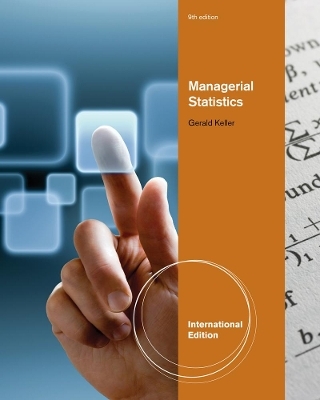
Managerial Statistics, International Edition (with Online Content Printed Access Card)
South-Western College Publishing
978-1-111-53463-9 (ISBN)
- Titel gebraucht verfügbar
- Artikel merken
This worldwide best-selling business statistics book teaches readers how to apply statistics to real business problems through the author's unique three-step approach to problem solving. Readers learn to IDENTIFY the right technique by focusing on the problem objective and data type. They then learn to COMPUTE the statistics either by hand, using Excel, or using MINITAB. Finally, they INTERPRET the results in the context of the problem. Keller's approach enhances user comprehension as well as practical skills.
Gerald Keller is Emeritus Professor of Business at Wilfrid Laurier University, where he taught statistics, management science and operations management from 1974 to 2011.
TABLE OF CONTENTS
1: What is Statistics?
1.1. Key Statistical Concepts.
1.2. Statistical Applications in Business.
1.3. Statistics and the Computer.
1.4. World Wide Web and Learning Center.
2: Graphical Descriptive Techniques I.
2.1. Types of Data and Information.
2.2. Describing a Set of Nominal Data.
2.3. Describing the Relationship between Two Nominal Variables and Comparing Two or More
Nominal Data Sets.
3: Graphical Descriptive Techniques II.
3.1. Graphical Techniques to Describe a Set of Interval Data.
3.2. Describing Time-Series Data.
3.3. Describing the Relationship between Two Interval Variables.
3.4. Art and Science of Graphical Presentations.
4: Numerical Descriptive Techniques.
4.1. Measures of Central Location.
4.2. Measures of Variability.
4.3. Measures of Relative Standing and Box Plots.
4.4. Measures of Linear Relationship.
4.5. (Options) APPLICATIONS IN PROFESSIONAL SPORTS: Baseball.
4.6. (Optional) APPLICATIONS IN FINANCE: Market Model.
4.7. Comparing Graphical and Numerical Techniques.
4.8. General Guidelines for Exploring Data.
5: Data Collection and Sampling.
5.1. Methods of Collecting Data.
5.2. Sampling
5.3. Sampling Plans.
5.4. Sampling and Nonsampling Errors.
6: Probability.
6.1. Assigning Probability to Events.
6.2. Joint, Marginal, and Conditional Probability.
6.3. Probability Rules and Trees.
6.4. Bayes’ Law.
6.5. Identifying the Correct Method.
7: Random Variables and Discrete Probability Distributions.
7.1. Random Variables and Probability Distributions.
7.2. Bivariate Distributions.
7.3. (Optional) APPLICATIONS IN FINANCE: Investment Portfolio Diversification
and Asset Allocation.
7.4. Binomial Distribution.
7.5. Poisson Distribution.
8: Continuous Probability Distributions.
8.1. Probability Density Functions.
8.2. Normal Distribution.
8.3. (Optional) Exponential Distribution.
8.4. Other Continuous Distributions.
9: Sampling Distributions.
9.1. Sampling Distribution of the Mean.
9.2. Sampling Distribution of a Proportion.
9.3. Sampling Distribution of the Difference between Two Means.
9.4. From Here to Inference.
10: Introduction to Estimation.
10.1. Concepts of Estimation.
10.2. Estimating the Population Mean when the Population Standard Deviation is
Known.
10.3. Selecting the Sample Size.
11: Introduction to Hypothesis Testing.
11.1. Concepts of Hypothesis Testing.
11.2. Testing the Population Mean when the Population Standard Deviation is
Known.
11.3. Calculating the Probability of a Type II Error.
11.4. The Road Ahead.
12: Inference about One Population.
12.1. Inference about a population Mean when the Standard Deviation is Unknown.
12.2. Inference about a Population Variance.
12.3. Inference about a Population Proportion.
12.4. (Optional) APPLICATIONS IN MARKETING: Market Segmentation.
13: Inference about Two Populations.
13.1. Inference about the Difference between Two Means: Independent samples.
13.2. Observational and Experimental Data.
13.3. Inference about the Difference between Two Means: Matched Pairs
Experiment.
13.4. Inference about the Ratio of Two Variances.
13.5. Inference about the Difference between Two Population Proportions.
14: Analysis of Variance.
14.1. One Way Analysis of Variance.
14.2. Multiple Comparisons.
14.3. Analysis of Variance Experimental Designs.
14.4. Randomized Blocks (Two Way) Analysis of Variance.
14.5. Two-Factor Analysis of Variance.
14.6. (Optional) APPLICATIONS IN OPERATIONS MANAGEMENT: Finding
and Reducing Variation.
15: Chi-Squared Tests.
15.1. Chi-Squared Goodness-of-Fit Test.
15.2. Chi-Squared Test of a Contingency Table.
15.3. Summary of Tests on Nominal Data.
15.4. (Optional) Chi-Squared Test for Normality.
16 Simple Linear Regression.
16.1. Model.
16.2. Estimating the Coefficients.
16.3. Error Variable: Required Conditions.
16.4. Assessing the Model.
16.5. Using the Regression Equation.
16.6. Regression Diagnostics - I.
17: Multiple Regression.
17.1. Model and Required Conditions.
17.2. Estimating the Coefficients and Assessing the Model.
17.3. Regression Diagnostics - II.
17.4. Regression Diagnostics- III (Time Series).
18: Model Building.
18.1. Polynomial Models.
18.2. Nominal Independent Variables.
18.3. (Optional) APPLICATIONS IN HUMAN RESOURCES MANAGEMENT:
Pay Equity.
18.4. Logistic Regression.
18.5. Stepwise Regression.
18.6. Model Building.
19: Nonparametric Statistical Techniques.
19.1. Wilcoxon Rank Sum Test.
19.2. Sign Test and Wilcoxon Signed Rank Sum Test.
19.3. Kruskal-Wallis Test.
19.4. Friedman Test.
19.5. Spearman Rank Correlation.
20. Time-Series Analysis and Forecasting.
20.1. Time Series Components.
20.2. Smoothing Techniques.
20.3. Trend and Seasonal Effects.
20.4. Introduction to Forecasting.
20.5. Forecasting Models.
21. Statistical Process Control.
21.1.Process Variation.
21.2. Control Charts.
21.3. Control Charts for Variables: and S Charts.
21.4. Control Charts for Attributes: p Chart.
22:Decision Analysis.
22.1.Decision Problem.
22.2 Acquiring, Using and Evaluating Additional Information.
23: Conclusion.
Appendix A Data File Sample Statistics.
Appendix B Tables.
1. Binomial Probabilities.
2. Poisson Probabilities.
3. Normal Probabilities.
4. Critical Values of t.
5. Critical Values of.
6. Critical Values of F.
7. Critical Values of the Studentized Range.
8. Critical Values for the Durbin-Watson Statistic.
9. Critical Values for the Wilcoxon Rank Sum Test.
10. Critical Values for the Wilcoxon Signed Rank Sum Test.
11. Critical Values for the Spearman Rank Correlation Coefficient.
12. Control Chart Constants.
Appendix C Answers to Selected Even-Numbered Exercises.
| Erscheint lt. Verlag | 28.5.2011 |
|---|---|
| Verlagsort | Florence |
| Sprache | englisch |
| Maße | 204 x 254 mm |
| Gewicht | 1705 g |
| Themenwelt | Mathematik / Informatik ► Mathematik ► Finanz- / Wirtschaftsmathematik |
| Mathematik / Informatik ► Mathematik ► Statistik | |
| ISBN-10 | 1-111-53463-2 / 1111534632 |
| ISBN-13 | 978-1-111-53463-9 / 9781111534639 |
| Zustand | Neuware |
| Informationen gemäß Produktsicherheitsverordnung (GPSR) | |
| Haben Sie eine Frage zum Produkt? |
aus dem Bereich



